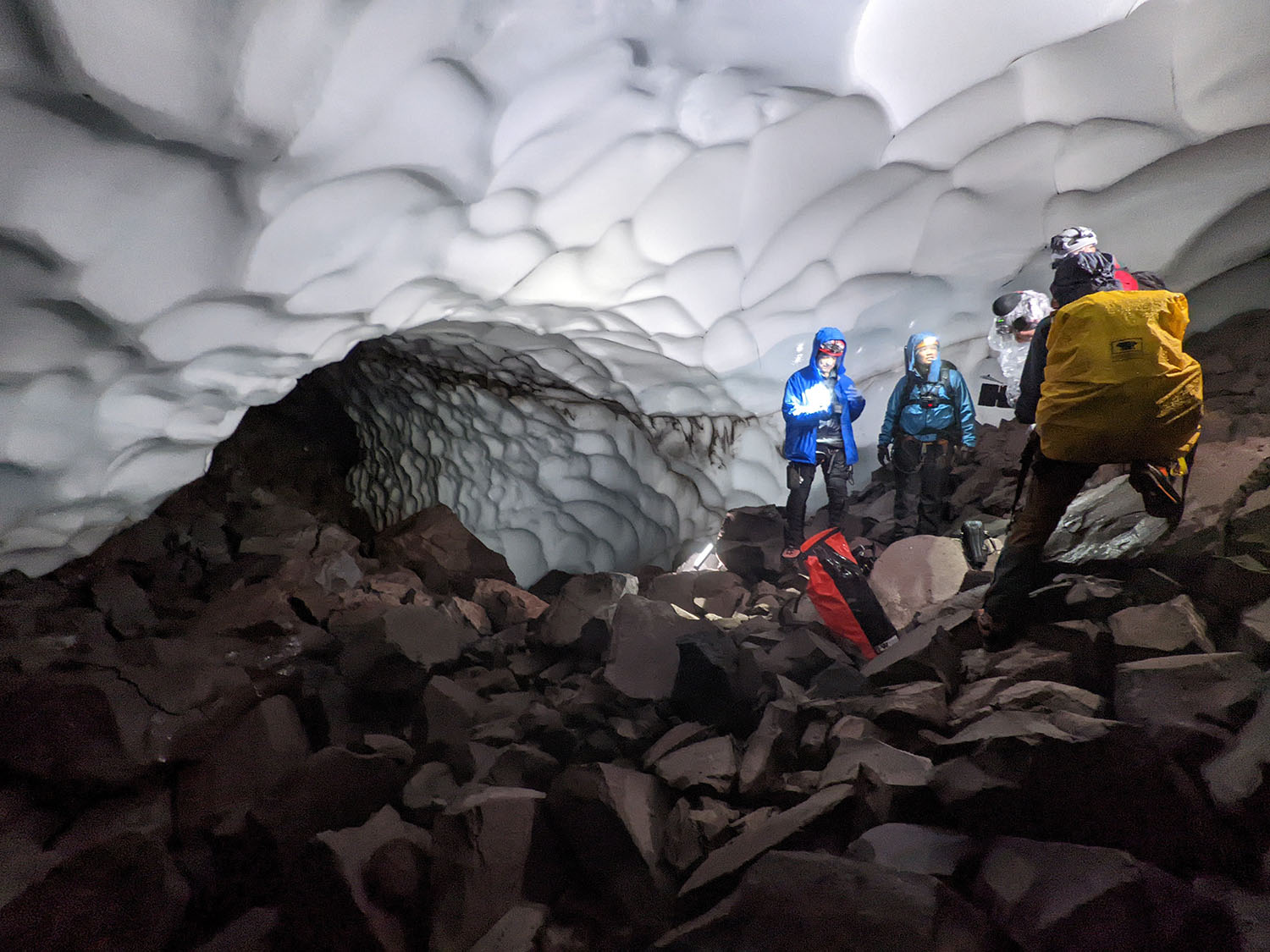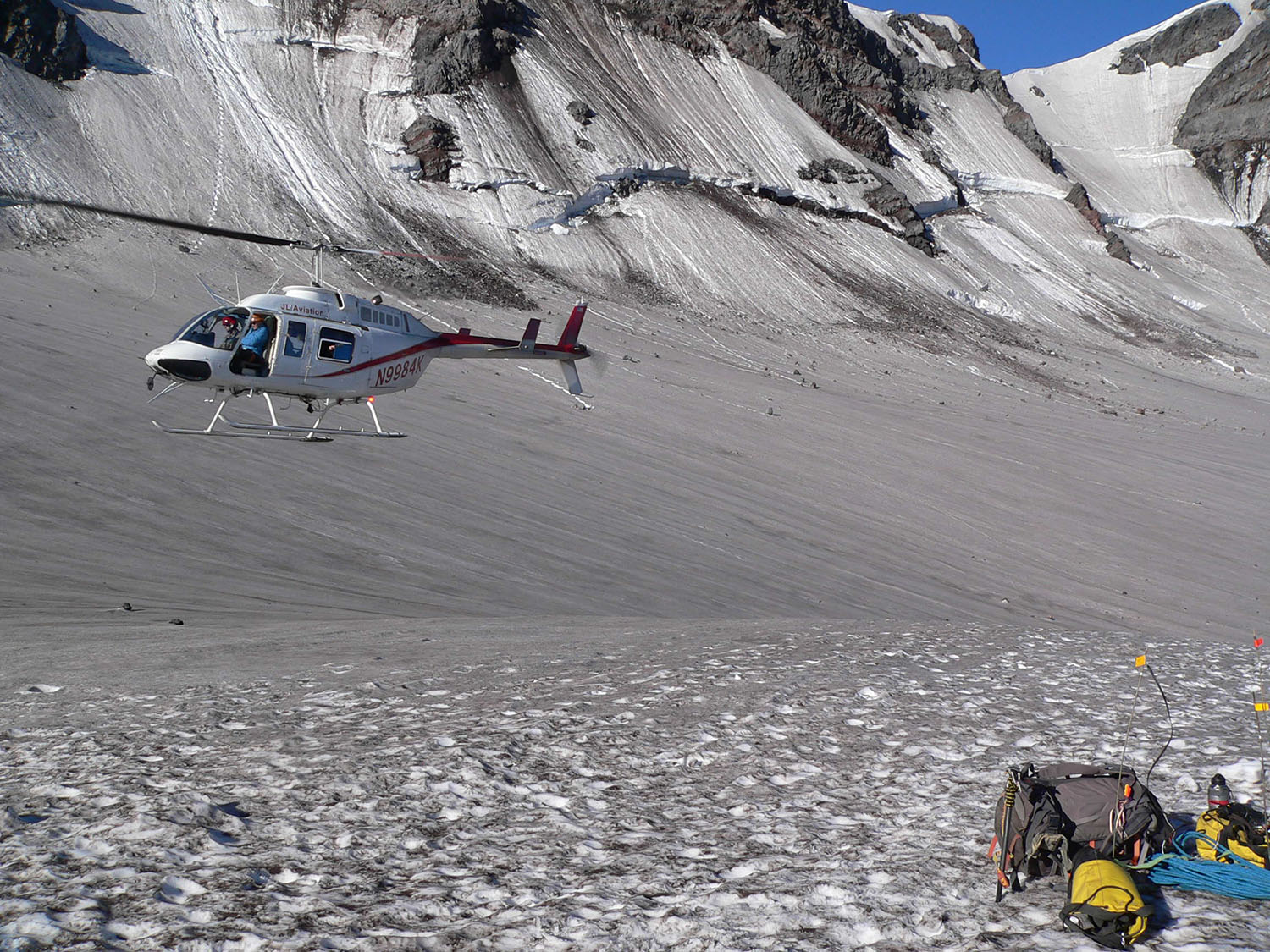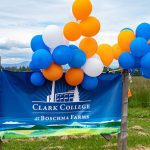Clark College professor goes to extremes
4 minute read
Explores ice caves in the crater of Mt. St. Helens looking for bacteria in extreme conditions

A July 2022 expedition in an ice cave on Mt. St. Helens. Clark professor Roberto Anitori is on the left, in the blue jacket. Photo by Rick Davis
Every summer since 2017, Dr. Roberto Anitori, professor of microbiology at Clark College, embarks on an unorthodox business trip.
Instead of checking into a hotel for a conference, he visits the crater at the top of Mt. St. Helens in Washington state. He typically climbs and spends five days camped on a glacier covering the volcano’s crater, collecting sediment samples from caves beneath the snow. This year, time constraints changed the itinerary so Anitori and other researchers from around the world rode in a helicopter to and from the crater two days in a row. Anitori slept in a Clark College van the night in between.
Beach House Pictures, a film production company based in Singapore, sent a documentary crew along for the trip. Anitori’s research will be the topic of one episode of a six-part series about the cryosphere, or portions of the Earth that are covered in ice.
As a microbiologist, Anitori understands that life exists almost everywhere on Earth. Scoop up a handful of soil from a garden and it’s teeming with microbes—tiny organisms such as bacteria. Garden soil is rich in nutrients from decomposing matter, roots, leaves and bugs.
“It’s like a buffet,” Anitori said.
Mars soil
But Anitori’s research focuses on microbes found in extreme environments. When Mt. St. Helens erupted in 1980, it essentially sterilized the crater, creating a blank slate. The samples he takes from this environment don’t even meet the definition of soil.
“We call it sediment; it’s not really soil… it’s actually very similar to what you would find on Mars,” he said.
But researchers including Anitori have found live bacteria in samples from these caves, and one of their main research questions is: how do they stay alive? While some microbes photosynthesize, these ones can not—the caves are dark. What then, do these tiny organisms eat?
Anitori and his colleagues have two hypotheses. The bacteria may absorb nutrients from volcanic gases such as carbon dioxide, carbon monoxide or hydrogen. Or they might pull elements such as nitrogen and phosphorus directly from the rocks on Mt. St. Helens. Either way, over a long geologic time span, these microbes likely help generate soil.
“When the Earth was formed, there was no soil,” Anitori said. “And microbes have a role in slowly breaking down rocks to make soil,” which sustains more complex life forms such as plants.
By paying close attention to Mt. St. Helens now, scientists like Anitori are getting a glimpse of how life first establishes itself in a new environment.

A look inside the crater on Mt. St. Helens, with a pile of research expedition equipment and the helicopter that took scientists to and from the crater. Photo by Roberto Anitori, July 2022
Also on his trips, Anitori collects samples for two courses at Clark, Biology 105 and Biology 106, in which students help the professor look for antibiotic activity in the sediment on Mt. St. Helens. Since 2014, Clark has participated in a national study with universities including Yale and Washington State University in Pullman, looking for new forms of antibiotics.
In the fall, Anitori’s Biology 105 students will take the samples into a lab and, through various tests, see if any of them contain microbes with antibiotic activity. Some microbes generate chemicals that harm other microbes—a form of self-defense that could potentially be harnessed to help kill harmful bacteria.
Students will also run tests to see if any antibiotics produced by these microbes kill a category of test microbes.
In the spring, Anitori’s Biology 106 students will take any microbes that have passed those two tests and sequence their entire genomes to identify their genetic blueprints. Once the microbes have been sequenced, Anitori and his students will compare their sequences with other confirmed and published sequences to determine whether they contain any genes specifically tailored to producing antibiotics, especially novel ones.
In other words, bacteria beneath the ice on Mt. St. Helens could hold the key to new medicines that are much needed in a world of growing resistance to the relatively small number of antibiotics currently available for use. The results of this research conducted by Clark students on Clark’s campus will be contributed to a national effort. By taking Anitori’s classes, Clark students get a chance to participate in a massive original research project.
Global scientists
When Anitori visits the top of Mt. St. Helens every summer, he is joined by more than a dozen other scientists as well as cave experts who accompany them for safety and logistical purposes. The expedition requires special permits because the glacier at the top of the volcano is so dangerous. Anitori works with Dr. Rick Davis, a former biology instructor at Clark who now works for NASA. They are also joined by a team of German climate scientists and a cave surveying team. This year was not the first time the group was joined by a film crew.
Anitori has taught microbiology at Clark since 2008. An award-winning scientist, Anitori received the Antarctica Service Medal in 2011 from the National Science Foundation. He has spent his career studying tiny organisms that live in extreme environments. He’s worked in Antarctica and also researched microbes that live in volcanoes, deep-sea vents, underground water tables and radioactive hot springs.
 Listen to Professor Roberto Anitori talk about extremophiles, microbiology and the DNA of dirt on our Penguin Chats podcast.
Listen to Professor Roberto Anitori talk about extremophiles, microbiology and the DNA of dirt on our Penguin Chats podcast.
Story by Lily Raff McCaulou, a journalist whose writing has appeared in The New York Times, The Atlantic, The Guardian, Rolling Stone and more. She lives in Bend, Ore. Visit her online at www.lilyrm.com.



